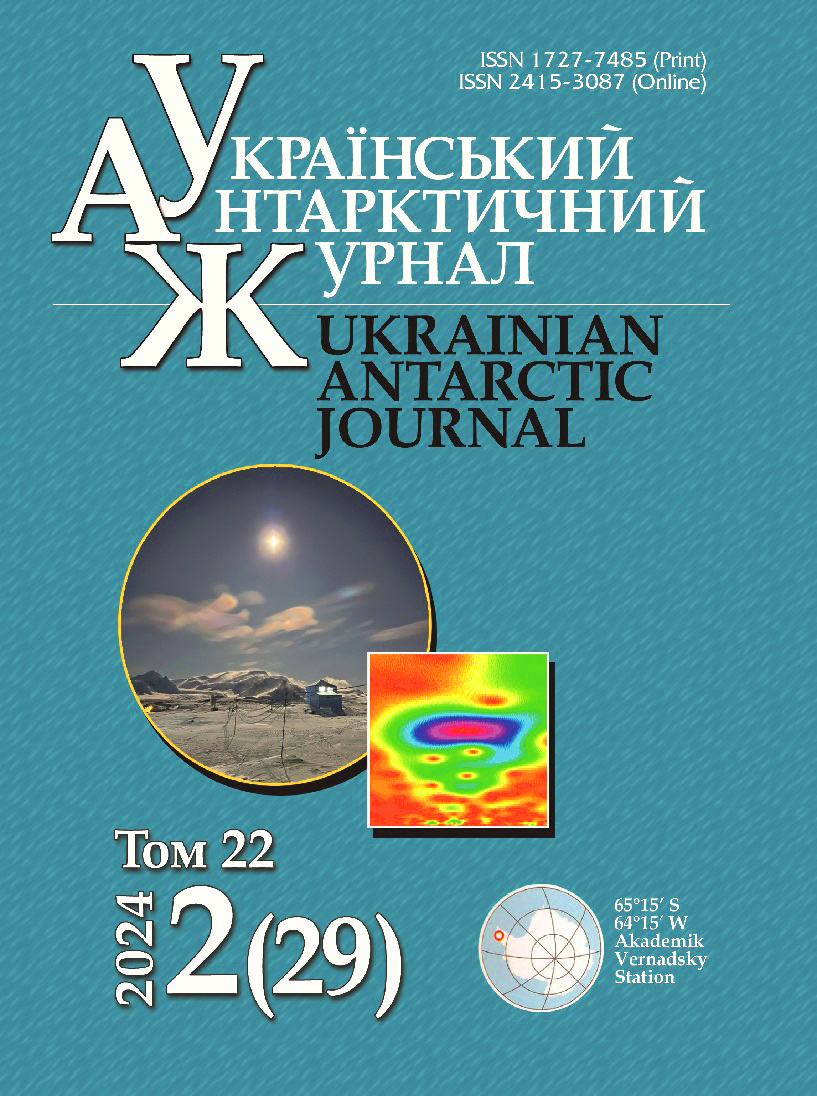Study of the magnetic response to the AGW propagation based on measurements at the Akademik Vernadsky station
- atmospheric gravity waves,
- geomagnetic pulsations,
- magnetic field fluctuations
Copyright (c) 2024 Ukrainian Antarctic Journal

This work is licensed under a Creative Commons Attribution-NonCommercial-NoDerivatives 4.0 International License.
Abstract
To find the electromagnetic response to the propagation of atmospheric gravity waves (AGWs), wave fluctuations of the magnetic field were studied according to measurement data at the Ukrainian Antarctic Akademik Vernadsky station. We analysed continuous data for three components of the geomagnetic field of January–March 2024. We considered wave fluctuations of the magnetic field in the period range of 5–60 min, which correspond to medium-scale AGW in the atmosphere. From January–March, a total of 500 wave events were analysed. The amplitudes ranged from ~one nT to several tens of nT. Two dominant period groups were observed: ~5–12 minutes (including the Brunt–Väisälä period) and 25–30 minutes. We suppose that this pattern indicates a different origin of the AGW. This new result indicates the experimental possibility of separating the effects of AGW influences “from below” and “from above”. Time intervals during the day when magnetic field fluctuations are observed most often were determined. In all three magnetic field components, fluctuations are observed simultaneously in the evening. In geomagnetically quiet conditions, there is a daily asymmetry in the frequency of occurrence of meridional and zonal disturbances. Wave activity in the meridional Bx and vertical Bz components is registered mainly in the morning and evening. In the component By, wave disturbances prevail in the daytime from 10 to 14 hours (UT) and are also observed in the evening. In March 2024, there were two geomagnetic storms during which the amplitudes of magnetic field fluctuations increased simultaneously in different period ranges. The fluctuations may be caused by modulation of polar current systems and/or dynamo-current generation during the propagation of AGW at heights in the E-region of the ionosphere. Further studies are needed to establish which mechanism contributes more to the phenomenon.
References
- Fedorenko, A. K, Bespalova, A. V, Cheremnykh, O. K., & Kryuchkov, E. I. (2015). A dominant acoustic-gravity mode in the polar thermosphere. Annales Geophysicae, 33(1), 101–108. https://doi.org/10.5194/angeo-33-101-2015
- Fedorenko, A. K., Kryuchkov, E. I., Cheremnykh, O. K., & Melnychuk, S. V. (2024). Propagation of acoustic-gravity waves in inhomogeneous wind flows of the polar atmosphere. Kinematics and Physics of Celestial Bodies, 40, 15–23. https://doi.org/10.3103/S0884591324010045
- Heyns, M. J., Lotz, S. I., & Gaunt, C. T. (2020). Geomagnetic pulsations driving geomagnetically induced currents. Space Weather, 19(2), e2020SW002557. https://doi.org/10.1029/2020SW002557
- Innis, J. L., & Conde, M. (2002). Characterization of acoustic-gravity waves in the upper thermosphere using Dynamics Explorer 2 Wind and Temperature Spectrometer (WATS) and Neutral Atmosphere Composition Spectrometer (NACS) data. Journal of Geophysical Research: Space Physics, 107(A12), SIA 1-1–SIA 1–22. https://doi.org/10.1029/2002JA009370
- Jacobson, A. R., & Bernhardt, P. A. (1985). Electrostatic effects in the coupling of upper atmospheric waves to ionospheric plasma. Journal of Geophysical Research: Space Physics, 90(A7), 6533–6541. https://doi.org/10.1029/JA090iA07p06533
- Kelley, M. C. (1989). The Earth’s Ionosphere. Plasma Physics and Electrodynamics. Academic Press, Inc. https://doi.org/10.1016/B978-0-12-404013-7.X5001-1
- Lizunov, G., Skorokhod, T., Hayakawa, M., & Korepanov, V. (2020). Formation of ionospheric precursors of earthquakes – Probable mechanism and its substantiation. Open Journal of Earthquake Research, 9(2), 142–169. https://doi.org/10.4236/ojer.2020.92009
- McPherron, R. L. (2005). Magnetic pulsations: Their sources and relation to solar wind and geomagnetic activity. Surveys in Geophysics, 26, 545–592. https://doi.org/10.1007/s10712-005-1758-7
- Negale, M. R., Taylor, M. J., Nicolls, M. J., Vadas, S. L., Nielsen, K., & Heinselman, C. J. (2018). Seasonal propagation characteristics of MSTIDs observed at high latitudes over Central Alaska using the Poker Flat Incoherent Scatter Radar. Journal of Geophysical Research: Space Physics, 123(7), 5717–5737. https://doi.org/10.1029/2017JA024876
- Paznukhov, V. V., Sopin, A. A., Galushko, V. G., Kashcheyev, A. S., Koloskov, A. V., Yampolski, Y. M, & Zalizovski, A. V. (2022). Occurrence and characteristics of Traveling Ionospheric Disturbances in the Antarctic Peninsula region. Journal of Geophysical Research: Space Physics, 127(11), e2022JA030895. https://doi.org/10.1029/2022JA030895
- Prakash, S., & Pandey, R. (1985). Generadon of electric fields due to the gravity wave winds and their transmission to other ionospheric regions. Journal of Atmospheric and Terrestrial Physics, 47(4), 363–374. https://doi.org/10.1016/0021-9169(85)90016-9
- Pulkkinen, A., Thomson, A., Clarke, E., & McKay, A. (2003). April 2000 geomagnetic storm: Ionospheric drivers of large geomagnetically induced currents. Annales Geophysicae, 21(3), 709–717. https://doi.org/10.5194/angeo-21-709-2003
- Saito, T. (1978). Long-period irregular magnetic pulsation, Pi3. Space Science Reviews, 21(4), 427–467. https://doi.org/10.1007/BF00173068
- Vlasov, D. I., Fedorenko, A. K., Kryuchkov, E. I., Cheremnykh, O. K., & Zhuk, I. T. (2022). Seasonal features of the spatial distribution of atmospheric gravity waves in the Earth’s polar thermosphere. Kinematics and Physics of Celestial Bodies, 38, 73–82. https://doi.org/10.3103/s0884591322020076
- Yampolsky, Yu., Zalizovsky, A., Litvinenko, L., Lizunov, G., Groves, K., & Moldvin, M. (2004). Magnetic field variations in Antarctica and the conjugate region (New England) stimulated by cyclone activity. Radio-Physics and Radio-Astronomy, 9(2), 130–151.
- Zhang, S.-R., Erickson, P. J., Coster, A. J., Rideout, W., Vierinen, J., Jonah, O., & Goncharenko, L. P. (2019). Subauroral and polar traveling ionospheric disturbances during the 7–9 September 2017 storms. Space Weather, 17(12), 1748–1764. https://doi.org/10.1029/2019sw002325


